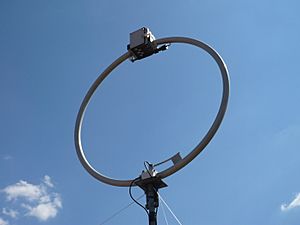Loop antenna facts for kids


A loop antenna is a special type of radio antenna that looks like a loop or coil of wire. It helps radios send and receive signals. Imagine a circle or square made of wire – that's often what a loop antenna looks like! There are two main kinds: small loops and resonant loops. Small loops are much smaller than the radio waves they pick up, while resonant loops are about the same size as the waves.
Small loop antennas are often used to receive radio signals, especially for things like AM radio. Most AM radios, except for car radios, have a small loop antenna built inside them or attached to them. These antennas are also useful for finding the direction of a radio signal, which is called radio direction finding. For amateur radio fans, loop antennas are a great choice when bigger antennas are not allowed or don't fit. They are also quite easy to build yourself.
Contents
Types of Loop Antennas
There are two main types of loop antennas, each with different uses and sizes.
Small Loop Antennas
Small loop antennas are also known as magnetic loops. They are usually much smaller than the wavelength of the radio waves they are designed for. This means their total length (the circumference of the loop) is less than one-tenth of the wavelength. Because they are small, the electric current flows pretty evenly around the wire.
Small loops are not very strong at sending out signals, but they are good at receiving them, especially for lower frequency radio waves. They are often found in everyday devices like AM radios.
Resonant Loop Antennas
Resonant loop antennas are much larger than small loops. Their size is chosen to match the wavelength of the radio waves they will work with. Usually, the total length around the loop is about the same as one wavelength.
These larger loops are mostly used for higher frequency radio waves, like those used for VHF (Very High Frequency) and UHF (Ultra High Frequency) signals. At these frequencies, the antennas are still a manageable size. Resonant loops are very good at sending and receiving signals efficiently, similar to a folded dipole antenna.
Uses of Loop Antennas
Loop antennas have many practical uses in radio communication.
Receiving Radio Signals
Many common radios, especially those for AM broadcasting, use small loop antennas. These antennas are good at picking up signals from radio stations. They are often hidden inside the radio casing.
Radio Direction Finding
Because of how they pick up signals, loop antennas are excellent tools for radio direction finding. They can help pinpoint where a radio signal is coming from. This is useful for tracking down signals or for amateur radio direction finding contests.
Amateur Radio
In amateur radio, where people communicate using radio as a hobby, loop antennas are very popular. They can be built in smaller spaces compared to other types of antennas. This makes them a good choice for people who live in apartments or have limited outdoor space. They are also known for being less affected by certain types of radio noise.
Images for kids
-
Amount of atmospheric noise for LF, MF, and HF spectrum according CCIR 322
-
The full wave loop (left) has maximum signal broadside to the wires with nulls off the sides, the small loop (right) has maximum signal in the plane of its wires with nulls broadside to the wires. (Pink and red represent "hot" or intense radiation; blue and indigo represent "cold" or low / no radiation.)
-
Ferrite loopstick antenna from an AM radio having two windings, one for long wave and one for medium wave (AM broadcast) reception. About 10 cm (4 in) long. Ferrite antennas are usually enclosed inside the radio receiver.
-
A loop antenna for amateur radio under construction
See also
 In Spanish: Espira (antena) para niños
In Spanish: Espira (antena) para niños








